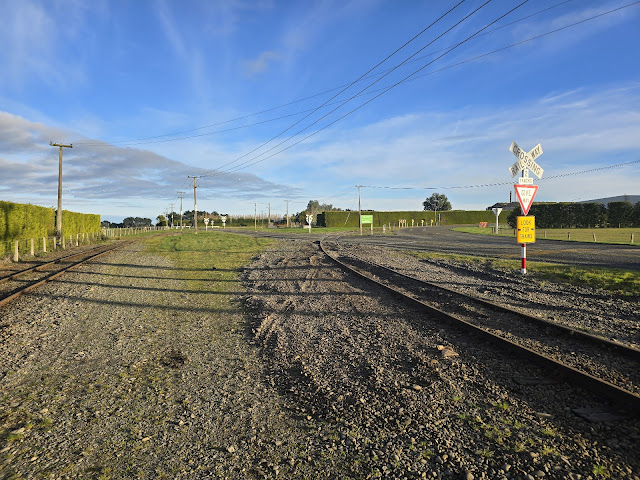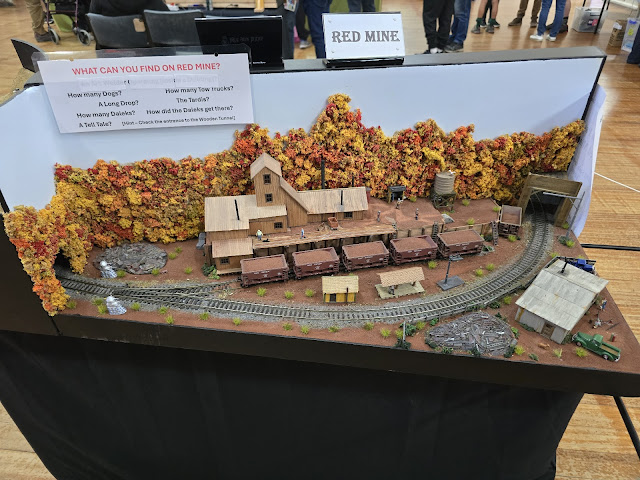 An Swiss Railways Ce 6/8 'Crocodile' locomotive hauls an auto train, a steam hauled passenger train and a railcar on Sam Cassels HO scale Marklin Mountain Village layout.
An Swiss Railways Ce 6/8 'Crocodile' locomotive hauls an auto train, a steam hauled passenger train and a railcar on Sam Cassels HO scale Marklin Mountain Village layout.
Weekends free of work commitments are few and far between, but through some fluke a rare free weekend lined up with the Ashburton Model Train Show. The show was held on the 6th and 7th of July at the Tinwald Memorial Hall.
Like most small community shows this one had a number of layouts of differing quality and a few hobby supply and second hand train stalls. When we arrived at around 10am on Saturday, the show was already busy with a good number of families making their way around the layouts.
First up was Wrexton, an N gauge British layout operated by the Garden City Model Railroad Club. This was a great layout with a double track main line, passenger station and yard. The layout kept spectators happy with a good range of trains passing by on the mainline. The detail on this layout was great and really showed off the benefits on N scale.
Mountain Village is an HO scale Marklin layout. Sam Cassel, the builder of the layout has packed a lot of action into a small footprint to produce an excellent exhibition layout. Spectators are kept entertained as trains loop and climb across each other and also stop at the station. This layout had a great range of locomotives, freight wagons and passenger cars and was fun to watch. The legendary electric 'Crocodile' locomotive was a personal favourite as it hauled a rake of car wagons around the layout.
The HO scale Cajon Valley and Red Mine layout is a regular at model train shows across the South Island. This simple little layout packs a lot into a small space and is a personal favourite of mine.
The line has heaps of details and a 'what can you find' encourages everyone to look closely in and around the layout. An awesome layout that I look forward to seeing again in the future.
Zuggarnitur is a wonderful German Z scale layout. This is the second time I have seen a Z scale layout and it is seriously small. How the manufacturers are able to make mechanisms for these locomotives is an incredible example of engineering.
One layout that I didn't get the name of was an N scale American outline exhibition layout. Like Wrexton, this layout had a double track mainline which offered plenty of action with many long freights and fast AMTRAK passenger trains. My favourite part of this layout was the rock work alongside a yard down one side of the layout.
OO scale Pendarves Castle was another small layout with an excellent model of Pendarves Castle. The Eurostar zipping around the small loop at high speed kept things interesting!
N gauge modular layout Falcalfe was another excellent exhibition layout designed to keep the interest of spectators. While the layout was of British outline, there was a range of trains running to keep the punters happy. This was a great layout with a number of different scenes. I really enjoyed the high quality construction of the cardboard kits on this layout.
Alongside the layouts was a model engineers stand with a range of static models including this beautiful live steam model of 0-6-0 locomotive Ym82.
My favourite layout of the show was Rawdon. This layout is an N scale layout representing a New Zealand Railway station somewhere on the West Coast of the South Island. This excellent layout was made up of a typical NZR track plan of main, passing loop and siding. The station yard also had a goods shed and coal mine sidings. This layout perfectly captured the feeling of a small town on the West Coast!
One of the really good things about this show was the number of interactive displays. Small kids were have a great time playing with toy trains on a large mat while older ones were able to operate a DCC switching layout using a smart phone. The organising committee should be congratulated for this initiative to get new people into our hobby.
Overall, this was a good solid show with enough to keep the public and enthusiasts happy. My highlight was the pride that the people that were displaying had in their layouts. From the outside looking in, it would feel daunting to put your work out there for all to see including the rivet counters. My thanks to the organisers and all the exhibitors for a good show.




















.jpg)




































